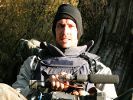Eye For Film >> Movies >> Which Way Is The Front Line from Here? The Life And Time Of Tim Hetherington (2013) Film Review

Which Way Is The Front Line from Here? The Life And Time Of Tim Hetherington
Reviewed by: Amber Wilkinson
"Moral outrage motivates me but I don't think it's a useful tool... You need to build bridges to people."
These are the words of photojournalist and documentarian Tim Hetherington, a man who this documentary tribute makes clear was driven to take pictures of war zones in a bid to capture the humanity of those fighting to live within them. He has a strong presence in virtually every frame of his former colleague Sebastian Junger's film, a fact made all the more poignant because on April 20, 2011, Hetherington was killed - along with fellow photojournalist Chris Hondros and a number of Libyans - while shooting footage of the war in Misrata. Although it isn't mentioned in this film, Hetherington wasn't killed outright in the attack but sustained a shrapnel wound which, because none of his fellow journalists knew what to do, proved fatal. Junger has since poured his considerable energy into Reporters Instructed in Saving Colleagues (RISC) to try to prevent similar deaths in future.

I mention this because it seems fitting that even his death has provided inspiration, as the picture painted is one of a man who was dedicated to not just to capturing people's images on camera but to talking to them and finding out what made them tick. The results are showcased for all to see, with many of Hetherington's striking images from Libya, Liberia and Afghanistan used to break up the various talking head observations. Documentary fans will, no doubt, already be familiar with his excellent camerawork on Pray The Devil Back To Hell, The Devil Came On Horseback and, most notably, on Restrepo - still the best documentary to be made about the Afghanistan conflict.
Junger intercuts footage of Hetherington himself, either speaking direct to camera about what motivates him, in war zones and at various Q&As with a long line of people who knew him personally - from his mum Judith and dad Alistair to former colleagues including Junger and journalist James Brabazon (also producer), with whom he worked extensively in Liberia. The footage of him with his photographic subjects is striking, showing his focus was always on interacting rather than simply observing.
This is chiefly a celebratory piece and inevitably concentrates on the positives of Hetherington's life, in particular, his humanitarian tendencies, which extended to putting himself between a gun and a potential victim on occasion. It is more than that, however, shedding light on what it means to be a journalist in a war zone, a job that Hetherington describes as "dangerous" and "addictive". Footage of those who are capturing conflict is rarely seen on our screens, so this is a chance to truly get a feel for what journalists go through to serve up our diet of 24 hour news. It's also clear all the men and women who have reported from conflict areas and offer their thoughts in this film are carrying their own scars, even if Junger insists that the "deep trauma comes from the pain of others".
Hetherington talks about his job setting him "free from a distructive tendency I had inside myself", but no one here is willing - or perhaps able - to add any more to that. The most perceptive comments about the man come, inevitably, from his parents, who see their son in the same way he looked at others - as a complex human to be treasured.
Reviewed on: 07 Oct 2013

















